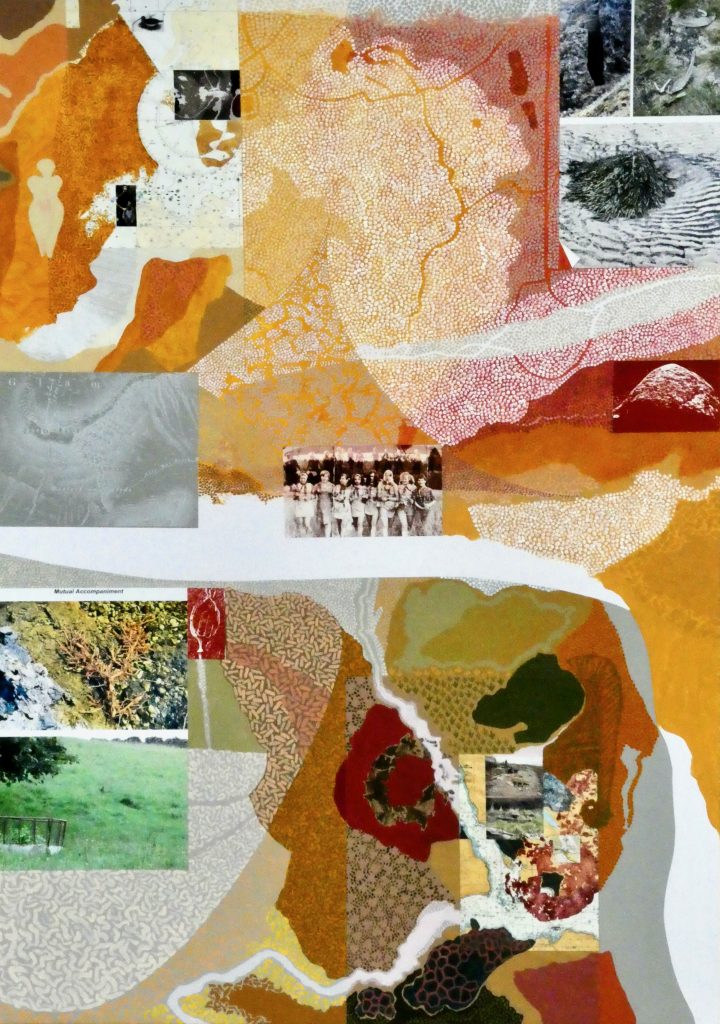
Author Archives: Iain
Quiet Conversations: Phil Lesh / Lucinda Williams 
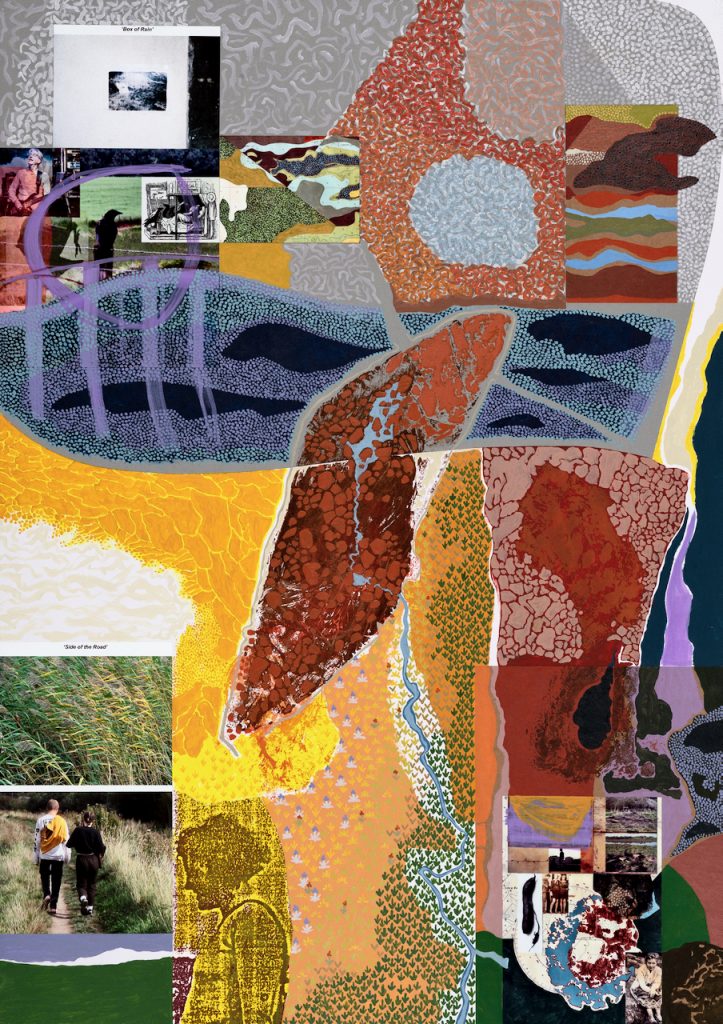
Phil Lesh. A musician and founding member of the Grateful Dead, with whom he played bass throughout their career. Box of Rain (with lyrics by Robert Hunter) was recorded in 1970 as the first track on the Grateful Dead’s American Beauty. Hunter is on record as saying that by ‘box of rain’ he intended the world we live on, an observation taken up in this image. The song was written at a time when Lesh was visiting his dying father in hospital.
Lucinda Williams. Singer, song-writer and musician, Williams recorded Side of the Road, the second song taken up here, in 1988. It is track ten on the album Lucinda Williams.
Note
Both these songs might be said to be linked to the genre now known as ‘Americana’. My interest in them is in the ways in which ‘the rural’ figures in these songs in ways that are not simply nostalgic.
Essaying Self, Wilderness, and Place: a response to issues raised by George Monbiot’s Feral. (Part Three)
In leu of a conclusion
As already indicated, I am personally involved in the experiences this exposition addresses. As someone involved for many years in ecosophical education I see Feral as deeply counterproductive; a negation of the value of care as mutual accompaniment and of place as taskscape. I write as someone who, as a child and adolescent, spent time alongside working people who cared deeply for a taskscape. Alongside Lea McNally, gamekeeper, author, stalker and naturalist, when trying to cull hinds in the almost impossible conditions of high winds and eddying snow. I have helping to gather some nine hundred ewes and their lambs, an exhausting twelve-hour walk to sweep nine thousand rough acres in early summer heat. Times spent in a place that, even as a teenager, I knew to be the consequence of a long and often deeply troubled history of human intervention, ownership, and displacement; and of infinitely longer biological and geological processes. A sense of place later articulated by Barbara Bender’s observation that:
Landscapes refuse to be disciplined. They make a mockery of the oppositions that we create between time [History] and space [Geography], or between nature [Science] and culture [Social Anthropology]; (Bender in Massey 2006: 33)
To which list I would add: ‘or between open and undisciplined attending’ (Art) and ‘careful observation of the natural world’ (the Environmental Sciences).
So what has my personal experience to do with Feral’s argument? Simply this. Between late childhood and late teens I gained first-hand experience of the work that constitutes and is constituted by a Scottish Highland taskscape. Work that communicated qualities of attention to that taskscape and of the skills inseparable from making a living in a particular physical place that was also a simultaneity of stories-so-far. Work by people who, like Dafydd Morris-Jones, his mother, and our neighbours in upper Weardale, know their place in the senses I have indicated here. My admiration and respect for such people is unchanged, although I now also understand the degree to which their taskscapes are caught up in larger, deeply problematic, economic and ecological narratives. What has changed, however, is that I now know that many of the people with those qualities of attention and skills today are also, as cultural bilingualists at-home in rural communities as polylocals. As persons living complex lives that don’t match traditional categories and who are helping co-create with particular taskscapes forms of post-rural community that both respect and re-inflect those qualities of attention and skill in full awareness of those larger economic and ecological narratives.
As a utopian fantasy Feral allows no place for such people. Yet an ecosophically-aware future requires a politics that enables human and more-than-human beings to live and thrive in upland taskscapes; to be able to register, maintain, and cherish a maximum number of alternative ways of belonging to a world desperately in need of ecological understanding, empathetic imagination, and the political subtlety to enable them. Monbiot’s promoting of blanket rewilding discounts such people, seeks to reduce complex taskscapes to a wilderness monoculture in service to his own obsession with solitary adventures that align with the corporate interests of the Adventure industry. Polylocal bilingualists are vital to the mediation of ecological projects, including reforestation, so that these respect both more-than-human and human needs. Needs best identified by selves as constituted by an ecosophical sense of community and respectful of the simultaneity of stories-so-far that help constitute taskscapes, and do so in accord with the principles of the Earth Charter.
Iain Biggs, Bristol, March 2022
Bibliography
Behar R (1996) The Vulnerable Observer: Anthropology That Breaks Your Heart Boston, Mass., Beacon Press.
Bellamy D & Quayle B (1989) England’s Last Wilderness: A Journey Through the North Pennines London, Penguin.
Bender B, quoted in Massey (2006) ‘Landscape as a Provocation: Reflections on Moving Mountains’ in Journal of Material Culture 2006; 11; 33 pp. 33-48.
Biggs I (2015) “’Incorrigibly plural’? Rural Lifeworlds Between Concept and Experience” in Canadian Journal of Irish Studies Vol. 38 nos. 1-2 2015 pp. 260 – 279
(2010) ‘Essaying Place: Landscape, Music, and Memory (after Janet Wolff)’ in Adeline Johns-Putra & Catherine Brace (eds) Process: Landscape and Text Amsterdam & New York, Rodopi.
Casey E S (1993) Getting Back into Place. Towards a Renewed Understanding of the Place-World Bloomington & Indianapolis, Indiana University Press.
Cresswell T (2004) Place: a short introduction Oxford, Blackwell.
Cronon W (1995) ‘The Trouble with Wilderness; or, Getting Back to the Wrong Nature’ (originally published in Cronon W (ed) Uncommon Ground: Rethinking the Human Place in Nature New York, W.W Norton & Co. 69-90.) The pagination referred to is that of the downloaded chapter found at: https://venusthinksblog.wordpress.com/the-trouble-with-wilderness-or-getting-back-to-the-wrongnature/#:~:text=William%20Cronon’s%20essay%20“The%20Trouble%20with%20Wilderness%3B%20or%2C,save%20the%20environment%20is%20by%20no%20human%20contact.
Deakin R (2008) Wildwood: A Journey Through Trees London, Penguin.
ní Dochartaigh K (2021) Thin Places Edinburgh, Canongate Books Ltd.
Finn G (1996) Why Althusser Killed His Wife: Essays on Discourse and Violence Atlantic Highlands, Humanities Press International.
Fowler C (2020) Green Unpleasant Land: Creative Responses to England’s Colonial Connections Leeds, Peepal Tree Press.
Genoko G (ed) (2008) Guattari: the three ecologies London & New York, Continuum.
Hayes N (2020) The Book of Trespass: Crossing the lines that divide us London, Oxford, New York, New Delhi, Sydney, Bloomsbury Circus.
Hillman J (2006) ‘The Heartbreak of America’ in Leaver R J (ed) City and Soul Putnam, Connecticut, Spring Publications Inc.
(1994) ‘”Man is by nature a political animal” or: patient as citizen’ in Shamdasani S & Munchow M (eds) Speculations after Freud: Psychoanalysis, philosophy and culture London & New York, Routledge.
Ingold T (2000) The Perception of the Environment: Essays in livelihood, dwelling and skill London & New York, Routledge.
Jamie K ‘A Lone Enraptured Male’ The London Review of Books Vol. 30 No. 5, 6 March 2008 pp. 25-27.
Surfacings (2019) London, Sort of Books.
Jamie K & Collins B (2013) Frissure Edinburgh, Polygon.
Kearney R (1993) Poetics of Imagining: from Husserl to Lyotard London & New York, Routledge.
(ed) (1996) Paul Ricoeur: the Hermeneutics of Action London, Thousand Oaks, New Delhi: SAGE Publications.
Latour B (2018) Down to Earth: Politics in the New Climatic Regime Cambridge & Medford, MA, Polity Press.
McKay D (2001) Vis à Vis: Field Notes on Poetry and Wilderness Wolfville, Gaspereau Press.
Massey D (2006) ‘Landscape as a Provocation: Reflections on Moving Mountains’ in Journal of Material Culture 2006; 11; 33 pp. 33-48, p. 33.
(2005) For Space London, Thousand Oaks, New Delhi: SAGE
Publications.
Monbiot G (2014) Feral: Rewilding the Land, Sea and Human Life London, Penguin.
Ray S J & Sibara J (2017) Disability Studies and the Environmental Humanities Lincoln & London, University of Nebraska Press.
Ricoeur P (1996) ‘Reflections on a new ethos foe Europe’ in Kearney R (ed) Paul Ricoeur: The Hermeneutics of Action London, Thousand Oaks, New Delhi: SAGE
Publications.
Rodwell J ‘In Praise of Rust’ in David Walker Barker Objects of Curious Virtue: echoes of John Ruskin (2010)
Schama S (1995) Landscape and Memory London, Harper Collins.
Solnit R Savage Dreams: a Journey into the Hidden Wars of the American
West Berkeley & London, University of California Press, (2014, first published 1994)
As Eve Said to the Serpent: On Landscape, Gender and Art (2001)
A Book of Migrations (2011, first published 1997)
‘Wilding in the last colony’, Y Tir, April 2019, https://www.fuw.org.uk/en/news/y-tir-newspaper
Watkins M ‘”Breaking the Vessels’: Archetypal Psychology and the Restoration of Culture, Community and Ecology’ in Marlan S (2008) Archetypal Psychologies: Reflections in Honor of James Hillman New Orleans, Spring Journal Books.
Essaying Self, Wilderness, and Place: a response to issues raised by George Monbiot’s Feral. (Part Two)
Self, Place and Testimonial Imagination
‘The Hushings’ chapter in Feral, which includes reference to an exchange between farmer and translator Dafydd Morris-Jones and Monbiot, is indicative of the lack of testimonial imagination necessary to underpin the empathetic dimension of an effective ecosophical politics regarding place. Like the upland regions in the North Pennines, Plynlimon in the Cambrian Mountains was mined for lead, particularly in the 19th century. This resulted in the inevitable vicissitudes associated with the expansion, and then retreat, of human activity and settlement in an area that still exhibits evidence of hushing, a form of surface mining. However, Feral’s singular historical concern with the Cambrian Mountains is with sheep and the environmental damage done by them. This despite the fact that Plynlimon today is in part the consequence of industrial activity by businesses such as the Plynlimon Mining Co., which yielded some 3,270 tons of lead concentrates between 1867 and 1897, and the Bryn-yr-Afr Mine. (I do not know whether this has resulted in the development of rare micro-ecologies of flora in areas with high lead residue, as is the case in Weardale. This is, however, a real ecological possibility). The last elements of a tramway, constructed to assist in the exploitation of minerals and grit stone, that ran through the Bwlchglas Farm property, remained intact until as late as 1926. All this matters here because, as the international community inches towards recognising ecocide[1] as a crime, it will be all too easy for demagogues looking for simplistic, monolithic causes such as the “sheep-shagging” of landscapes, to implant in the popular imagination “historic’ acts of ecocide by minority groups. Monbiot’s ignorance of, or disinterest in, the complexity and full range of lived experience in the various aspects of Plynlimon’s history is clear throughout Feral and needs to be vigorously contested.
Oddly perhaps, given the passionate sense of self-belief that pervades Feral, Monbiot writes of Morris-Jones that: ‘he had something … few people possessed: He knew who he was. I envied him that’. (2014:172) I suggest that Morris-Jones knows who he is because, unlike Monbiot, he knows his place. Knows it, that is, in terms of the lived connections between the past and present dynamics of place as taskscape understood as ‘the totality of tasks making up the pattern of activity of a community’. (Ingold 2000:325) A place that is the totality within which his living, both economically and psychosocially, inseparable from the ‘tight connection between geographical place and assumptions about normative behaviour’ which enable us to judge people and practices as ‘in-place’ or ‘out-of-place’. (Cresswell 2004:103-103)
Monbiot’s particular view of rewilding and disinterest in the witnessing central to the testimonial imagination indicates the cause of his sense of the smallness of his life in Wales; perhaps inevitable given his wilful out-of-place-ness in both senses. The numerous social and place-oriented generalities, lacuna, and evasions in Feral reflect its author’s contempt for the actually-existing world in which he found himself. His attention is on lone kayak adventures and projections of a mythic “wild” world onto a wished-for future landscape, not to the Cambrian uplands as a complex taskscape.
Today there are many views on what constitutes “wildness”, “wilderness” and “rewilding” offered by people with an informed and genuine interest in the ecosophical complexities of the relationship between self, society and place. Kathleen Jamie indicates one such when reflecting on Robert Macfarlane’s encounter, among the Burren’s limestone pavements, with a miniature wilderness hidden within a gryke. She suggests another in Frissure (2013), a bookwork with the artist Brigid Collins, and another again in ‘Voice of the Wood’, the final chapter in Surfacings (2019). An earlier example would be William Henry Hudson’s classic A Hind in Richmond Park (1922). Kerri ní Dochartaigh addresses these issues in Thin Places (2021), where the risk and uncertainty Monbiot seeks in the wild occur in the context of human violence, addiction, depression and suicidal ideation. Roger Deakin indicates another understanding again in the chapter ‘Staying Put’ in Wildwood: A Journey Through Trees (2008). Gary Snyder, however, makes the most emphatic claim, writing that:
A person with a clear heart and open mind can experience the wilderness anywhere on earth. It is a quality of one’s own consciousness.[2] The planet is a wild place and always will be’. (Quoted in Cronon 1995: 19)
Regardless of whether or not the reader agrees with one or more of these understandings, their sheer range emphatically contradicts Monbiot’s demagogic assumption that he speaks for “us”, that “we” share his desire for a particular way of enacting rewilding.
Towards an ecosophical understanding of self-in-place.
The first principle of The Earth Charter, under the heading ‘Respect and Care for the Community of Life’, asks that we respect life on Earth in all its diversity by recognizing that: ‘all beings are interdependent and every form of life has value regardless of its worth to human beings’; a principle that in turn requires affirming: ‘faith in the inherent dignity of all human beings and in the intellectual, artistic, ethical, and spiritual potential of humanity’.[3] Any self that accepts the principles of the Earth Charter will find itself at odds with the ego-driven assumptions of the dominant culture of possessive individualism. There are various articulations of such an alternative view of self, many derived from long-standing spiritual or Indigenous traditions. I have chosen to offer a different articulation.
James Hillman has argued for a sense of self understood ‘as the interiorization of community’, so that: ‘the draw towards interiority must at the same time be a draw toward exteriority’; towards ‘the contingencies of the actual ecological field’ in which a person finds themselves placed. What places us with regard to that actual ecological field is, he suggests, the sense of who we are with, of what is happening with our neighbours, including neighbouring animals, of how we are with our food, our furniture, with what our various accoutrements ‘do in the field I am in’. (1994:35-36) I take this to be a call to attend to our ‘actual ecological field’ in ways that allow us to live in the world as both “wild” and as it actually is, given that the ‘contingent and changing concrete world always exceeds the ideal categories of thought within which we attempt to express and contain it’. (Finn 1996:171). An attention that knows, with Gary Snyder and the Canadian poet, editor and educator Don McKay, that wilderness is ‘not just a set of endangered spaces, but the capacity of all things to elude the mind’s appropriations’. (McKay 2001:21)
Drawing on Edward Simpson, Hillman also points out that: ‘there are no subjects who can be defined apart from the world’ so understood, and that ‘persons are constituted in and through their attachments, connections and relationships’. (1994:32) Consequently, and in respect of our being ‘always both more and less than the categories that name and divide us’, (Finn 1996:171) we too are always part of that wildness. Monbiot’s declaration of ecological boredom can, then, be seen as a consequence of his failing to pay sufficient attention to his actual ecological field; to his ‘sitting and writing, looking after my daughter and my house, running …. watching the seasons cycling past’; (2014:7)[4] to a lack of attention that would place him in that field. However, the attention that places us in that field and that, in Snyder’s view, allows us to experience wilderness anywhere on earth, is precisely predicated on moving ‘away from the self, away from personalism, away from me and mine’. (Hillman 2006:126) That means away, too, from “my” desire for an exaltation, as a lone individual conceived as apart from community and culture, found in a wilderness that, far from eluding the mind’s appropriations, is very much predicated on concepts derived from a particular historical culture.
Hillman’s view of self stands over against the ‘elaborate fantasy of individualism’ that echoes ‘the splendid isolation of the colonial administrator’; over against representative figures in a culture still living with presuppositions based on ‘the theological God of monotheism’, the ‘God-apart-from-the-world’. (1994:33) That is the God in whose image Adam, the original lone male, was created. If we wish to move on from that archaic position I would suggest, following Hillman, we need a sense of self as the ‘interiorization of community’, (ibid.:36) where community is understood in the expanded sense that permeates The Earth Charter. To understand the ramifications of such a sense of self-as-community requires an investment in testimonial imagination so as to revisit our understanding of our actual relationship to place in all its dimensions.
Revisiting senses of place
The historian of American landscape William Cronon asks what the problems associated with the wilderness mentality ‘can tell us about home, the place where we actually live’. (1995:17) He suggests that we need to broaden ‘our sense of the otherness that wilderness seeks to define and protect’; that in reminding us that we find ourselves in a world we did not make, our sense of what is wild evokes a necessary ‘humility and respect’ with regard to ‘our fellow beings and the earth itself’, placing a limit on ‘human hubris’. (Ibid.) The amplification of Cronon’s response offered here starts with the dual sense of place offered by Edward S Casey: ‘if a position is a fixed posit of an established culture, a place, despite its frequently settled appearance is an essay in experimental living within a changing culture’. (199331) The significance of this can be illustrated as follows.
Since 1988 upper Weardale has increasingly been framed by the bureaucratically generated designation of an AONB and UNESCO Global Geopark, which are oriented in large part towards the tourist industry. An early and indicative example of this is the Introduction to England’s Last Wilderness, where the dales are described as ‘green wilderness corridors’ that:
‘provide a retreat for some, rich pickings for the historian and the natural scientist, and sport and recreation for many, not just for the seasoned walker or backpacker, but for the casual motorist looking for beauty, peace and solitude’. (1989:8-10).
The “wilderness” of the upper dale is thus positioned as a retreat from a crowded urban life and even as facilitating a negation of time itself, in that: ‘the vista is as magnificent as it was … over fifteen centuries ago’; indeed providing a God-like viewpoint that renders ‘the affairs of men … shallow, short-lived, tenuous things’. (ibid.:2)
Weardale as place and taskscape require articulation through a continual essaying[5] of multiple shifting activities and narratives; of the totality of the activity of a community, where community includes both human and more-than-human actors. An inclusive mesh of relationalities that, in terms of the part played by humans, is negotiated through both action and narrative. Thus Weardale-as-place includes Doreen Massey’s notion of space as the ‘simultaneity of stories-so-far’; (2005:9) stories of particular relevance to testimonial imagination. Place is inseparable from a multi-generational sense of shared care and responsibility, the elements of which are assessed and reactivated empathetically through a balancing of testimonial and utopian imagination.
Elements of an eco-ethical political imagination
Ricoeur’s discussion of the role of imagination in politics indicates the flaw in Monbiot’s approach to rewilding. Rather than facilitating the process of consultation necessary to give communal legitimacy, both Feral and related texts by Monbiot exacerbate the possibility ‘of incommunicability through a protective withdrawal’ (Ricoeur 1996: 4) on the part of local communities. Fortunately, such communities increasingly include persons able to act as ‘cultural bilingualists’, capable of engaging with ‘the mental universe of the other culture’ by taking ‘account of its customs, fundamental beliefs and deepest convictions’. (ibid.: 5) This bilingualism makes it possible, at least in principle, to revise the wholly negative story presented by, in this case, Feral and related texts so as to ‘take account of other events’. (ibid.:6) This is facilitated, ironically enough, by Monbiot’s own inability to take any responsibility, via empathetic imagination, ‘for the story of the other, through the life narratives which concern the other’. (ibid.: 6-7) Feral’s imaginative failure lies in its author’s refusal to even begin to imagine the legacies of the suffering of others grounded in those neglected regional histories to which testimonial imagination gives witness, let alone to do so before considering his own “suffering” in relation to an absence of the wilderness necessary to meet his personal desires.
Given Casey’s distinction between position and place, it might be argued that Ricoeur’s ‘cultural bilingualists’ are, figuratively speaking, also ‘polylocal’; at least in so far as they are able to work across more than one cultural mentality. (Solnit 2011(1997):182) Solnit’s notion of polylocality provides access into a more inclusive and complex sense of the multiple relationships between “urban” and “rural” inhabitation and the mentalities commonly associated with them.[6] Its value lies in complicating distinctions around at-home-ness between indigenous “locals”, “incomers”, second-home owners and casual visitors. Many of the culturally bilingual individuals I have in mind are polylocal in being at-home in a rural place, while earning a part of their living in a discursive setting predicated on an “urbane” mentality. As a result they are well placed to enact Bruno Latour’s understanding that what matters most is: ‘managing to register, to maintain, to cherish a maximum number of alternative ways of belonging to the world’. (Latour 2018: 15-16) They may combine, for example, work grounded in the discursive worlds of translation, university teaching or the arts, with farming or other rural employment.
[1] Strictly speaking, ecocide is defined as ‘unlawful or wanton acts committed with knowledge that there is a substantial likelihood of either severe or long-term damage to the environment being caused by those acts’. However such terms, deployed with the emphasis on rhetorical effect that characterises Monbiot’s writing at its most aggressive, would no doubt be used without subtlety or proper attention to its strict definition. Feral suggests that “anything goes” when it comes to trying to obtain maximum popular support for “rewilding”.
[2] Regarding this ‘quality of one’s own attention, see the section on Notitia in Watkins M (2008).
[3] The Earth Charter can be downloaded as a pdf at https://earthcharter.org/wpcontent/uploads/2020/03/echarter_english.pdf?x79755
[4] As the father of, and one of the long-term carers for our forty-two year old disabled daughter since she was thirteen, the implicit contempt for, and boredom with, the work of everyday care implicit in this passage seems to me particularly telling. It indicates that the central motivation for Monbiot’s environmental “radicalism” is less a genuine concern to address the ‘wicked problems’ consequent on our socio-environmental circumstances than a selfishness that insists he be allowed to indulge his own desires and opinions and cultivate his own self-regard. Such problems cannot usefully be address by perpetuating the “masculine” qualities perpetuated by possessive individualism and require the cultivation of the genuine ecological concern articulated in The Earth Charter.
[5] For a discussion of what is intended by essaying in this context see Biggs I , 2010.
[6] For further discussion of the relationship between designations of inhabitation and related mentalities see Biggs I 2015.
Essaying Self, Wilderness, and Place: a response to issues raised by George Monbiot’s Feral. (Part One)
Introduction / Points of departure
In an earlier draft of this essay[1] I wrote that it is intended for friends and colleagues in Wales, Ireland, and Scotland working on “rural” issues. Revisiting it, I have to acknowledge that this is not entirely true. It is also written to enable me to understand why Feral made me angry, why it seemed an attack on the ecosophical principles I have shared with friends and students for many years. What was it that that lurked just beneath the rhetorical surface of Monbiot’s righteous environmental indignation that smelled like the rankest possessive individualism, the conquest mentality that created the issues it claims to resolve?
The approach adopted draws on Geraldine Finn’s warning against ‘the traditional assumptions of high-altitude thinking, thinking forgetful of its contingent roots in particular persons, places and times’, and on her argument for placing greater emphasis on the task of ‘keeping alive local memory and imagination as a reservoir of meanings, truths, and possibilities for a different future’.(1996:137&141] Consequently I begin by acknowledging the convergence of circumstance and friendship that have animated this essay, an acknowledgement that also constitutes a declaration of interest.
I’m indebted to conversations with Lindsey Colbourne, the coordinator of Utopias Bach, about her tree nurturing activities, her ways of getting to know Dyffryn Peris since moving there in 2005, and about the impact of tourism in upland north Wales.[2] Conversations that were given additional significance by a doctoral candidate who introduced me to the conflict over the future of the Plynlimon in the Cambrian mountains where she lives. A conflict between the Summit to Sea project, supported ideologically by Monbiot’s Feral: Rewilding the Land, Sea and Human Life (2014) and in practice by his charity Rewilding Britain on one hand, and a local community that saw this as threatening its sense of place, its economic future and its Welsh-language cultural identity on the other.
An important circumstance was reading the dedication in my late parents-in-law’s copy of England’s Last Wilderness: A Journey Through the North Pennines (1989). This walking guide, by ecologist David Bellamy and environmental journalist Brenden Quayle is dedicated to ‘Walter, Old Willie, and all the Wild Men’, and was published within a year of the 1988 designation of the North Pennines as an Area of Outstanding Natural Beauty (AONB). This area includes Weardale in County Durham, the home of my wife’s maternal ancestors and a place that I’ve visited annually for some forty years. This reference helped contextualise the issues in Wales and the “Wild Men” mentality by linking them to my experience of an upland place that has much common with Plynlimon.
I’m also indebted to my friend Rowan O’Neill, who suggested me as a speaker to a group of Welsh artists and academics. A group setting out to address the issues raised for rural areas like upland communities by post-Brexit change, including interventions like the Summit to Sea initiative, and with which I’ve subsequently worked as a consultant. I was at that time involved in similar work taking place in both the Irish Republic and Scotland and studying with Haumea, an online initiative delivering eco-literacy education set up by the forester, educator, eco-activist and artist Cathy Fitzgerald. I’m also indebted to Ewan Allinson for help with information and for a sharing of interests and concerns.
As the above makes clear, what follows is not “objective” in the usual academic sense. Rather it is informed by, and respects, friendships and loyalties both new and old.
‘It is no extravagance to formulate the problem of the future …in terms of
imagination’.
Paul Ricoeur’s detailed articulation of ‘political imagination’ (in Kearney 1996:3), together with Richard Kearney’s elaboration of its structural dynamics (1991), provide one point of reference for this essay. Felix Guattari’s understanding of the interrelationship of the three ecologies of self, society and environment, another. (Genosko 2008) It is on the basis of the interaction between such ideas and my lived experience that I suggest that Feral is predicated on a flawed amalgam of ungrounded utopian vision, an outdated conception of self, an inflated projection of a personal predilection, and a reductive approach to complex psychosocial and place-based issues.
George Monbiot’s almost obsessive identification with rewilding is shot through with assumptions, both explicit and tacit, about a heroic, risk-taking masculinity he sees as intolerably restricted by the demands of contemporary life. A form of life he sees as no longer able to offer him access to the ‘high, wild note of exaltation’ he craves. [2014:26] An experience of exaltation that is, none the less, very largely dependent on the mediating socio-economic circumstances that provide him with the financial means, leisure time and possibilities of ownership necessary to afford him such experiences as a solitary encounter with a freak wave and eye-to-eye contact with a large bull dolphin in the wild. In short, his wilderness experience is highly mediated by his location within the economics of the culture he desires to escape.
My main concern here is not, however, with the intertwining of a rewilding mentality and the American-inspired Adventure or Risk culture predicated on marketing the experiences of exaltation that preoccupy Monbiot. Rather it is with the psychosocial circumstances necessary to effect ecosophical action. I want to sketch out a basis for a political imagination on which to establish genuinely ecosophical approaches to the changes needed in order to prevent both ecological and social collapse. Nothing in what I write is intended to diminish our need to respond to the deplorable state of the UK’s rural ecologies, or as an argument against the judicious and appropriate reforestation of land in places like Plynlimon and Weardale. My exposition does however require accounting for the flaws Feral exhibits. Flaws that, as I hope events in the Welsh uplands will subsequently show, are counterproductive to its author’s aims and damaging to the need to realise genuinely ecosophical change more generally.
The persistence of wilderness thinking
The publication and reception of Feral indicate that, despite the considerable volume of thinking (e.g. Solnit 1994 & 2001, Cronon 1995, Schama 1995, Jamie 2008, Ray 2017) that unpacks uncritical identification with ‘the sublime and the frontier’, (Cronon 1995:3) or with an Edenic thinking that perpetuates Western civilization’s ‘oldest story’ (Solnit 2001:12), such identifications persist regardless. It is important to acknowledge that they do so in no small part because encounters with wilderness, despite this being a highly particular cultural construct, remind individuals that they are inseparable from the ecological systems that sustain their lives. Experience of what is called wilderness is both a source of genuine wonder and insight and a marketable cultural product eulogised as the habitat of what Kathleen Jamie names ‘the lone enraptured male’. (2008). Analysis of the socially problematic historical, cultural, gendered, and ableist aspects of the wilderness mentality has not diminished it, since it is now the basis for a heavily-marketed international Adventure or Risk industry as a sub-set of global tourism.
What follows will reject the dominant conception of both rewilding and the self to take up a specific view of place and placed-ness linked to an understanding of self-as-community; one that values ‘emotional intimacy, anthropomorphic empathy, aesthetic appreciation and ritual devotion’. (Hillman 2006:335) An approach currently being explored in practice in Wales through the experiments of Utopias Bach.[3] Grounded in a testimonial relationship to place, this is a small-scale utopianism enacted in day-to-day life via the playfully critical spirit of endeavours such as Fluxus. It offers, that is, an adventurous alternative to the inflated, ungrounded utopianism that animates Feral’s case for rewilding. In what follows I have viewed Feral on the basis of Kathleen Jamie’s injunction that: ‘if we read about “nature” or wild places, it pays to wonder, who’s telling me this, who’s manipulating my responses, who’s doing the mediating’? (2008:3).
A failure of eco-ethical imagination
This approach assumes that Feral is intended to have real effects in the world. For example, that its violent attack on upland sheep farming in Wales is intended to prepare the ground for large-scale blanket rewilding through projects such as Summit to Sea.[1] Support presumably intended to counter any public concern about the psychic and socio-cultural consequences of such a project on the small and economically vulnerable upland Welsh community it would effectively displace and dismantle.
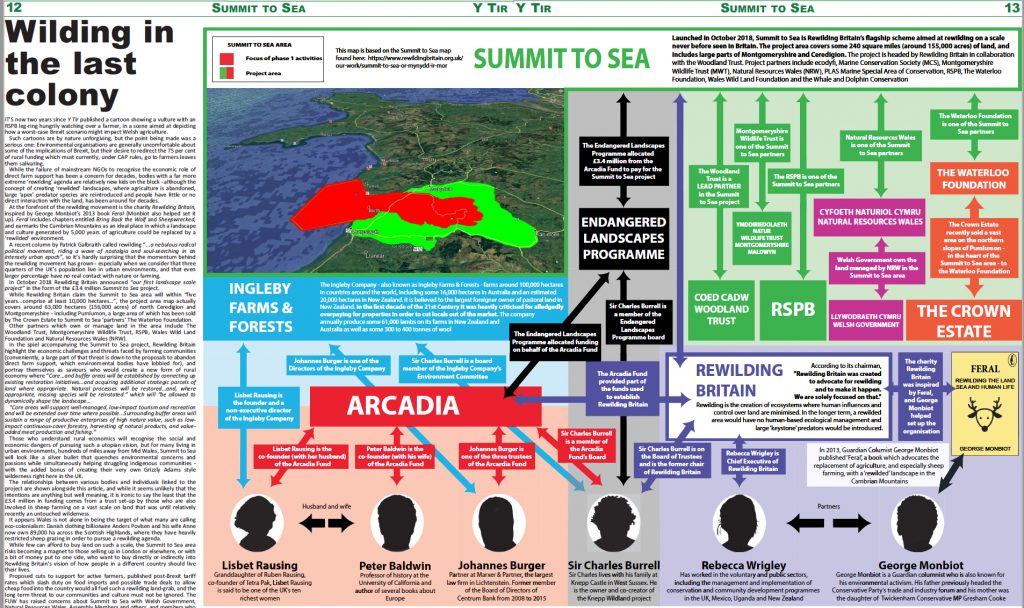
Fig. 1 ‘Wilding the Last Colony’ Y Tir, April 2019
I won’t elaborate on Monbiot’s position when, in its April 2019 edition, Y Tir produced an Illustrated article pointedly entitled ‘Wilding in the Last Colony’. [See Fig. 1 above]. This sets out the network of influence and funding sources behind the first iteration of the Summit to Sea project, which included Monbiot’s Rewilding Britain charity. It is sufficient to say that, given the role the vilification of sheep and upland sheep farming central to his promotion of “rewilding” Monbiot, himself a highly paid investigative journalist, was unwise to join an alliance that received funding from the Ingleby Company, owners of farms in New Zealand and Australia that annually produce over sixty thousand lambs and between three and four hundred tonnes of wool.
Richard Kearney argues that imagination has ‘crucial ethic powers’ in addition to ‘poetic powers’; ethical powers vital to our taking action and that he summarizes as: ‘the utopian; the testimonial; and the empathetic’. (1993:218) He views the testimonial imagination as putting ‘itself in the service of the unforgettable’, as an act of witnessing, (ibid:223), arguing that if the utopian imagination fails to attend to such witnessing it: ‘risks degenerating into empty fantasy’ because ‘it forfeits all purchase on historical experience’. (ibid:220) It is in just this respect that I suggest Monbiot’s ungrounded utopianism is deeply problematic. For reasons I will discuss later, it floats free of the lived historical experience of those his proposals would most immediately effect. Such a version of rewilding implies, as the ecologist John Rodwell points out, a degree of forgetfulness of the past that could be ‘considered a pathology’. (2010: 21) In terms of the political imagination as Ricoeur and Kearney understand it, Monbiot’s selectively citing extensive economic and scientific “facts” in support of rewilding is, in terms of the imagination required by an effective politics, largely beside the point.[5] As the inclusion of the word ‘colony’ in the title of the Y Tir article suggests, Feral’s failure of imagination lies in failing to take account of the deeply felt consequences of the historical experience of those communities it would most directly affect.
How not to initiate ecosophical change
Feral opens by establishing Monbiot’s self-proclaimed status as a “wild man” happy to eat live grubs on the basis of memories of former adventures in the South American jungle. It goes on to tell the reader of his admiration for a man ‘who had abandoned comfort and certainty for a life of violent insecurity’ and who, despite his slim chance of ‘coming out alive, solvent and healthy’ from the dire situation in which he had placed himself may, in Monbiot’s eyes, have made the right choice. (2014:2) In short, it begins by signalling the author’s preoccupation with risk and the ‘high, wild note of exaltation’ obtained in the wild; (ibid) the same preoccupations serviced by a growing Adventure Culture predicated on selling “wilderness”. (Ray in Ray & Sibara 2017:29) We are also told that, having moved to rural Wales, Monbiot felt diminished by the ‘smallness’ of a lacking the uncertainty, fear, courage, and aggression that he believes ‘evolved to see us through our quests and crises’. (2014:6) (A view at odds with a growing scientific view of evolutionary development that stresses the importance of social bonding and cooperative).[6] Consequently, a reader might be forgiven for thinking that statements like: ‘Rewilding, to me, is about resisting the urge to control nature and allowing it to find its own way’ (ibid.:9) are primarily an expression of the author’s own internal conflicts.
For this reader the most disconcerting aspect of Feral is not the implication of the arguably questionable use of scientific “evidence” to support its case. (Scientific data always being dependent on framing and interpretation for its social meaning). Rather it is everything Monbiot fails to address. Feral was published eight years after Kathleen Jamie’s A Lone Enraptured Male, a review of Robert Macfarlane’s The Wild Places, which illuminates the problematic assumptions that run through popular attitudes to “wild” nature. Monbiot’s blithe disregard of the issues Jamie raises is reflected in his failure to acknowledge the influence of class, gender, nationality, and the legacies of colonialism in his notion of wilderness. Furthermore, Feral fails in the terms H. L. Mencken uses to define good journalism, namely that: ‘It should “afflict the comfortable and comfort the afflicted”’.[7] It is hard to avoid seeing Feral as written specifically to confirm the prejudices and ignorance of a particular, comfortably-off, “environmentally conscious” urban readership that regards places like the Welsh uplands as little more than holiday destinations. Its argument is made at the expense of remote upland rural communities it claims survive only because supported by its readers’ taxes. This, and it’s vilification of sheep and those whose identity and precarious economic survival depends on them, is an apt measure of Monbiot’s balancing of “comfort and affliction”.
The significant absences in the grandiosely titled Feral: Rewilding the Land, Sea and Human Life are legion. Given that title, it would not be unreasonable to expect Feral to offer less autobiography and more careful contextualisation. It might be expected to include, in no particular order, most or all of the following points. Consideration of the relative merits of blanket reforesting versus the judicious restoration of bog in upland Wales, given both that the latter is three times more effective in terms of carbon capture than the former and the location of the watersheds of the Severn and Wye rivers. Consideration of issues related to forest farming with regard to the diversification of habitat and the need for a sustainable human economy, both seen in the context of the inevitability of increasing food security issues. A detailed discussion of private and corporate land ownership and of access to existing woodland.[8] A balanced assessment of social benefit between investment in urban greening measures and large-scale rewilding. Of particular importance given that urban greening enhances the quality of life of the large element of the population financially debarred from Adventure tourism and in countering pollution through such strategies as planting green screens around schools. Critical consideration of Government subsidy to the privately-owned grouse shooting industry over a period when the Environment Agency, which serves the public good, has suffered substantive funding cuts. Consideration of the distortion of environmental debate by a media industry geared to an audience without lived experience of the rural working communities it is increasingly encouraged to denigrate, and of the political and economic interests that denigration serves. Particular consideration of the ways in which “rewilding” is entangled in global networks of economic investment in tourism and lucrative Adventure-related industries. Most importantly, however, consideration of the relationship of such specific issues and socio-environmental concerns to long-term infrastructural, energy and social well-being issues.
Feral merely nods to, skirts over, or ignores such issues. Instead we are given the chapter ‘The Beast Within (Or How Not to Rewild)’ that tries to distance Monbiot’s proposals from those of politically authoritarian regimes by insisting that rewilding must not be imposed by Governments. There is no analysis, however, of large-scale rewilding currently being conducted by business interests and wealthy individuals, or of how public rejection of Government intervention would favour such individuals and businesses. All this despite our being told that rewilding should not aim to produce ‘a paradise for the rich’ extracted ‘from the lands of the poor’. (2014:208) Monbiot takes care to reference Simon Schama’s exoneration of modern environmentalism from any kind of historical kinship with totalitarianism. This is particularly disingenuous, since it is used to support Monbiot’s claim that ‘large-scale restoration of … natural processes can take place without harming anyone’s interests’. (ibid.) Perhaps it can. However Monbiot chooses to ignore the racist, elitist and ableist attitudes that informed rewilding in North America and continue to constitute the less savoury aspects of the ‘corporeal unconscious’ of the contemporary Adventure and Risk industries. (Ray 2017). The second half of Rebecca Solnit’s Savage Dreams: a Journey into the Hidden Wars of the American West, focused on Yosemite National Park, demonstrates just how far from the truth Monbiot’s claim about the harmlessness of rewilding is. To read Feral in the light of Solnit’s exposition is to be made aware of a number of uncomfortable parallels between the treatment of Native Americans in the USA and the more insidious, but ultimately no less coercive, forces that Monbiot argues should be applied to Welsh-speaking upland farming communities.[9]
[1] What follows here is an essay in the sense Ruth Behar gives the term, namely: ‘an act of personal witnessing’. (1996:20).
[2] See https://lindseycolbourne.com/fy-milltir-sgwr-my-own-projects-and-interventions
[3] See https://www.utopiasbach.org
[4] See http://www.summit2sea.wales
[5] See Hillman J 2006: 335 for the reasoning behind this assertion.
[6] See, for a recent example of this in magpies:
https://www.sciencealert.com/scientists-attached-tracking-devices-to-magpies-that-s-when-things-got-weird?fbclid=IwAR3KPFTlmTzRiy__5HtKAQK0mKeyWZgLo3ZwRQKyh_76xhJk008ocR1Igxk
[7] Quoted by Will Self, see https://www.vice.com/en/article/kwpvax/will-self-charlie-hebdo-attack-the-west-satire-france-terror-105
[8] See, for example, Fowler 2020, Hayes 2020.
[9] Forces independently discussed in some detail by Monbiot’s critic, Dafydd Morris-Jones, see https://play.acast.com/s/bbccountryfilemagazine/rewildingwiththreatenwelshculture-saysfarmerdafyddmorrisjones
Quiet Conversations: Paula Meehan / Michael and Barbara Coulthard
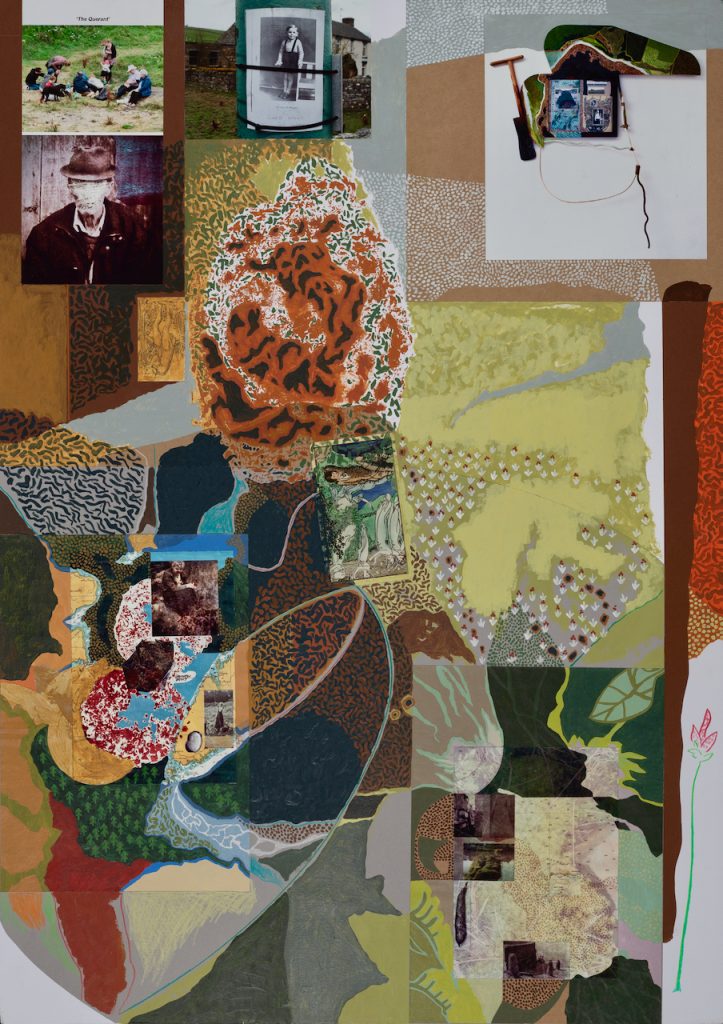
Paula Meehan. The poem The Querant is from Meehan’s 2016 collection Geomantic.
Michael and Barbra Coulthard. Farmers and our neighbours in Co. Durham
Note:
The top right hand of the painting employs a photography of Flight/Paths: (Her bones…), which I gifted to the Moore Institute at NUI, Galway, in thanks for time spent on a fellowship there. It circles around the interwoven themes of peat, memory and loss that hark back to specific exchanges with Irish artists concerning the complexities of Irish rural life and of the country’s ecological problems. Meehan’s The Querant was a touchstone for that piece, together with the third section of Eavan Boland’s Anna Liffy, which evokes a place of rushes, ling heather, black peat and bracken that I identify with from childhood days spent in the highlands of Scotland. Together they provided a starting-point for the landscape elements of the work.
Quiet Conversations: Grace Wells / Meg Bateman
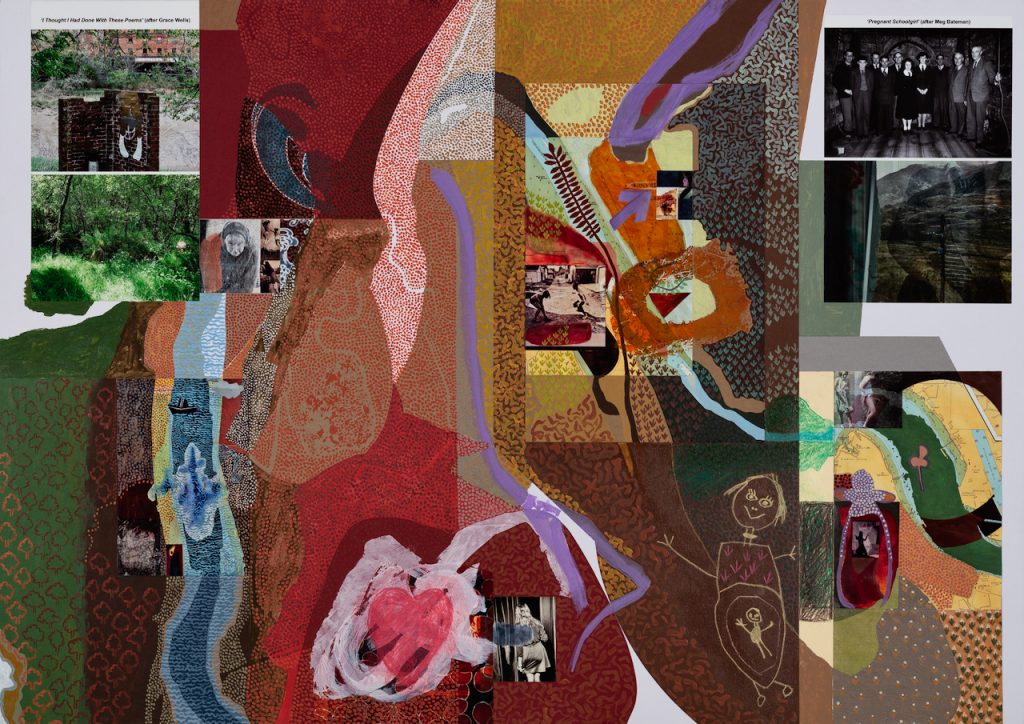
Grace Wells. A London-born eco-poet, author, re-wilder, and yoga teacher, Grace Wells has lived in the Republic of Ireland since 1991 where she is currently the Poet Laureate for Ennistymon, Co Clare. Her poem ‘I Thought I Had Done With These Poems’, a point of reference for this work, concludes the section ‘Becoming Animal’ in Fur (2015).
Meg Bateman. A Scottish poet, lecturer at the Gaelic-speaking college Sabhal Mòr Ostaig on the Isle of Skye, translator and short-story writer. She writes in both Gaelic and English. Her poem Pregnant Schoolgirl, the other point of reference for this work, appears in Transparencies (2013).
Note:
Grace Wells’ poem brought to mind Ken Kiff’s comment to me, made in connection to a question about his painting Excrement (1) (The Sequence no. 57), that nothing could be more natural than going to the toilet. I now see his attitude as related to Nuala Ní Dhomhnaill’s statement that, in the Irish language, issues relating to ‘orifices and excrements’ are understood without prudishness or purulence ‘as “an nádúir”, or “nature”, a source of … laughter rather than anything to be ashamed of’. (Collected Essays Dublin, New Island 2005: 18). I read a somewhat similar attitude in Meg Bateman’s poem; perhaps an acknowledgement (with an implicit smile of regret?), of her own resistance to the irrepressible energy of life that the poem celebrates.
Quiet Conversations: Eavan Boland / Lynne Cooke
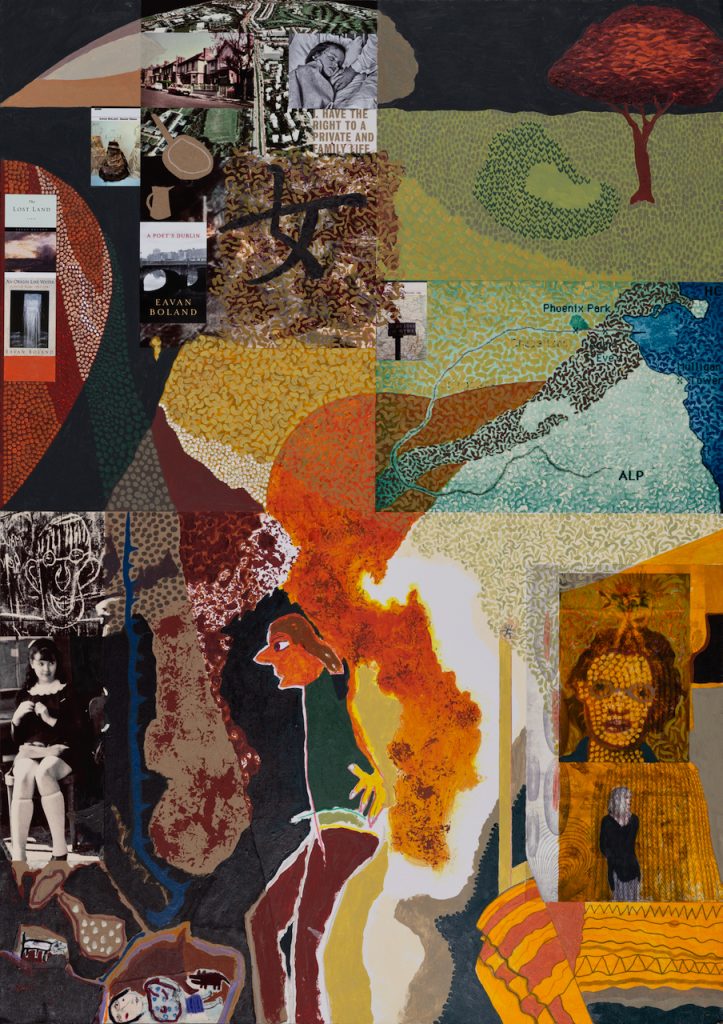
Eavan Boland (1944-2020). An Irish poet, writer and professor at Stanford University with some forty publications to her name. Her New Collected Poems (2008), the study A Journey With Two Maps: Becoming a Woman Poet (2011), and Eavan Boland: A Poet’s Dublin (2014), edited by Paula Meehan and Jody Allen Randolph, are the main points of reference here.
Lynne Cooke. Australian born, Cooke is an internationally acknowledged curator, teacher and writer on art. She is at the time of writing Senior Curator, Special Projects in Modern Art, at the National Gallery of Art, Washington DC.
Note:
Boland’s concern as a poet was to ensure that babies and washing machines found an equal place in Irish poetry alongside, say, politically-motivated murder. A concern that for me speaks to the need, in visual art, to struggle against what Cooke refers to as the “categorical distinctions and formalist teleological art histories” still active in the subconsciousness of those who would arbitrate what is and is not proper to the activity of making art.
Cooke organised the exhibition Outliers and American Vanguard Art (2018), which includes important essays by Darby English, Suzanne Hudson and herself, among others, that have had a significant impact on my thinking and this body of work.
Quiet Conversations: Paula Meehan / Karl Kerényi
(the artktoi)
Paula Meehan:
Imaginary Bonnets With Real Bees In Them, which includes the poem The Solace of Artemis. (Artemis is one of the Goddesses for whose forgetting Grace Wells asks her daughter Holly’s forgiveness in her poem The Forgetting).
Karl Kerényi:
‘A mythological image of girlhood’ in James Hillman (ed). Facing the Gods Dallas, Texas, Spring Publications, Inc. (This short chapter is dedicated to his nine-year-old daughter).
Note:
Paul Shepard argues that shamans are latecomers whose psychic politics largely displaced earlier “spontaneous healers, usually women”, one of the changes that, he claims: “marked the decline of the great cults of the bear”. (Paul Shepard Coming Home to the Pleistocene Washington DC / Covelo, California, Shearwater Books 1998: 91-92). Curiously, in this context, at the Bronze Age Dartmoor Whitehorse Hill tomb site that contained meadowsweet, referenced in this series in connection to Kathleen Jamie’s poem of that name, it was a bear pelt that contained the cremated remains in the tomb, probably those of a high status young woman between fifteen and twenty-five years of age.
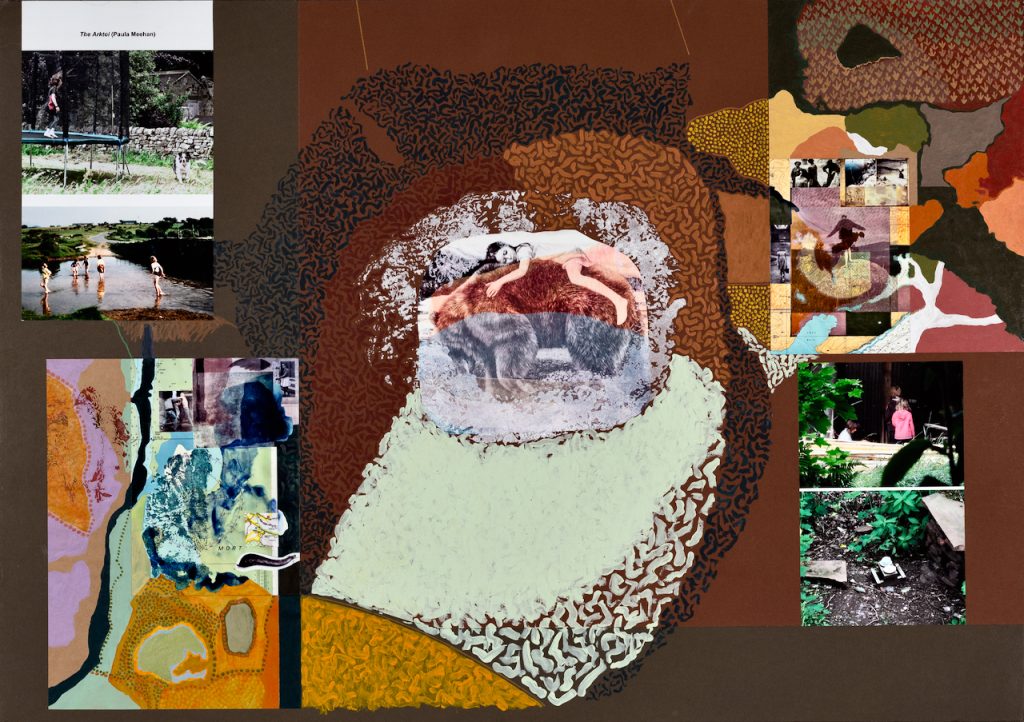
Quiet Conversations: Kathleen Jamie / Erin Kavanagh (Meadowsweet)
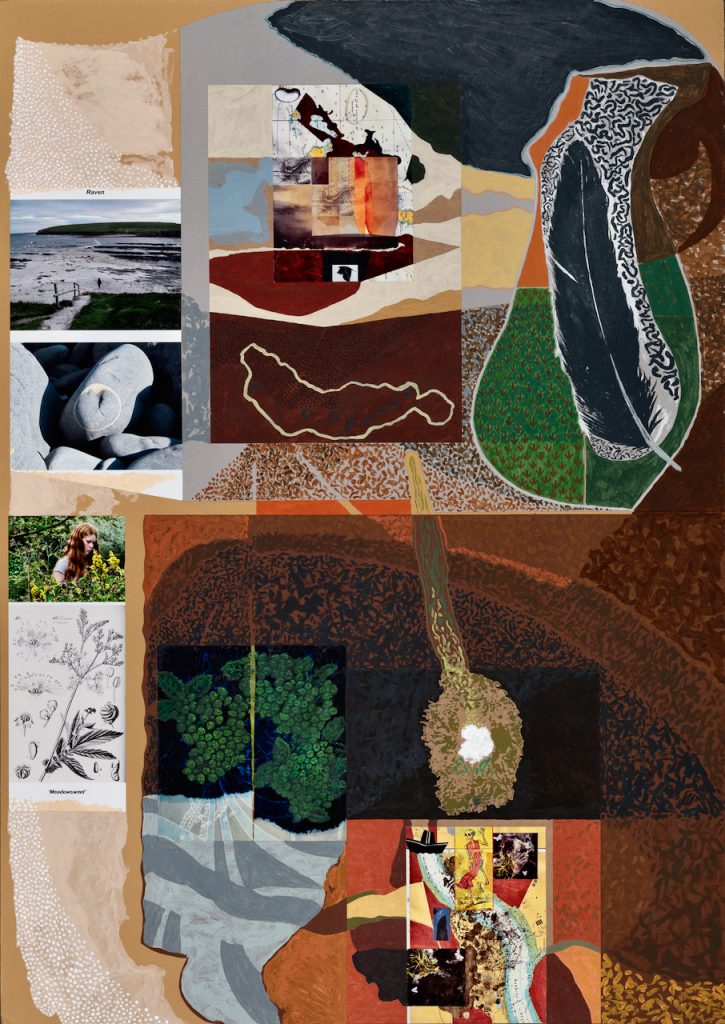
Kathleen Jamie. Scots poet and essayist who in 2021 became Scotland’s forth Makar. The key reference here is to her poem Meadowsweet, which appears in Waterlight: Selected Poems (Saint Paul, Minnesota, Graywolf Press, 2007).
Erin Kavanagh. Irish by birth, long resident in Wales and Welsh-speaking, is a polymath, a poet, musician, artist and mythogeographer. We have collaborated on 2017 she and I collaborated on two performances lectures: The Crow Road (2017) https://www.geomythkavanagh.com/geomythkavanaghthe-crow-road, a version of which is published as The Crow Road: performing bridge-making (Green Letters 23:3 2019) and The Selkie (2019) https://www.geomythkavanagh.com/the-selkie. These two works draw on our shared interest in exploring processes grounded in the inclusive, polyvocal mentalité often referred to as ‘deep mapping’.
Note:
Jamie’s poem is prefaced by a reminder that tradition in Scotland suggests that certain Gaelic women poets were buried face down. (One such who is said to have requested such a burial is Màiri nighean Alasdair Ruaidh, also known as Mary Macleod). Such burials were reserved for individuals that the community, or those who claimed the authority to act on its behalf, saw as deviant or undesirable, for example those deemed to be “witches”. The idea appears to have been that, when the Last Judgement was announced, such individuals would dig down into the earth rather than rise into the light. In Meadowsweet, however, the dead poet returns to the living world, young again and full of ‘dirt and spit and poetry’. Why meadowsweet? Traces of meadowsweet have been found in Bronze Age burials in Wales, Scotland and on Dartmoor. It has a long tradition of use in treating illness, contains salicylic acid, a compound of which was synthesised to develop aspirin. In Welsh mythology Gwydion and Math fab Mathonwy made Blodeuwedd (“flower face”) out of oak blossom, broom, and meadowsweet. Yet in parts of Wales and elsewhere it was believed that if a person fell asleep in a room where Meadowsweet flowers were placed, death was inevitable. My wife vividly remembers how upset her grandmother was when, in 1972, she and her sister had brought meadowsweet into the cottage in County Durham where her grandfather was seriously ill.